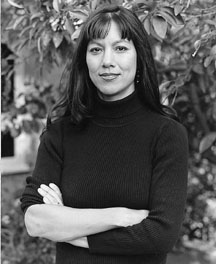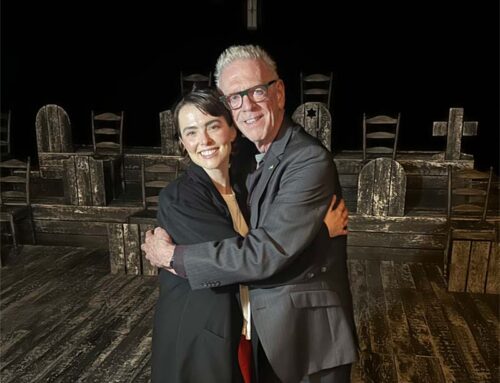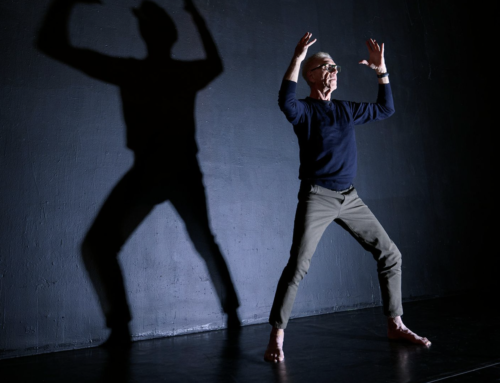(Written by Greg Braxton, this article first appeared in the Los Angeles Times, January 12, 2006).
More artists — many armed with little more than courage in their own material — are taking up the challenge of going it alone onstage.

Billy Crystal
BILLY CRYSTAL is accustomed to full houses in large theaters when he performs “700 Sundays.” But he jokes that the cast party can be a bit lonely — he’s the only one there.
Comedian Tracy Esposito is not accustomed to full houses in the small theaters where she has performed her one-woman show. But she is upfront about her reasons for abandoning her native New York for Los Angeles: Her show is her introduction and calling card to Hollywood.
Performance artist Sandra Tsing Loh says that even if her one- woman show about a mother’s frantic search for the right kindergarten lands her an offer for a role on a wacky network TV sitcom, her choice will be clear: She’ll stick with acting out her comic frustration with her own words and in her own way, thank you very much.
These three performers are part of an expanding group of artists who for various reasons have taken up the challenge of going it alone onstage, baring their souls to degrees that can be alternately illuminating or embarrassing. Instead of having other performers to play off, these artists want to be left alone, interacting only with their observers — strangers willing to hear their tales of personal triumph or woe.
Their productions have contributed to an explosion of one-man and one-woman shows around town. Almost any night of the week, local theatergoers can encounter solo performers in spaces ranging from the vastness of the 1,910-seat Wilshire Theatre near Beverly Hills to the intimate no-frills confines of the 99-seat Complex in Hollywood’s Santa Monica Boulevard theater district.
“There’s no shortage of artists who want to tell their stories, and audiences are always interested in autobiographical pieces,” says Terence McFarland, executive director of L.A. Stage Alliance, a nonprofit organization dedicated to generating awareness and support of local creative arts. “From a producer’s standpoint, these shows are very inexpensive to put on. And solo shows with multiple characters provide a great platform for a performer to demonstrate their chops.”
The art form is flourishing, McFarland says. In 2003, 25 solo shows were produced around town; last year, at least 54 were produced.
“We like to hear personal intimate insights that we can connect to,” says Jean-Louis Rodrigue, who teaches theater at UCLA. Rodrigue worked with Heather Raffo on her highly praised “Nine Parts of Desire,” a show about the women of Iraq that was recently presented by the Geffen Playhouse at Brentwood Theatre.
Monologues and solo pieces have historically been a mainstay of theater, largely due to their anything-goes nature. Whoopi Goldberg, Lily Tomlin, Hal Holbrook, Dame Edna and the late Spaulding Gray are among hundreds of marquee stars who have solidified their status with one-person multi-character shows.
Performances can vary in intensity and energy. Loh, in constant frantic motion during “Mother on Fire,” goes into the audience at one point, playfully assaulting them with her exasperation. French film star Isabelle Huppert took another approach when she appeared in “4.48 Psychose,” Sarah Kane’s play about her suicidal thoughts, jotted down before she hanged herself in 1999. For almost two hours, Huppert stood rooted to the stage of UCLA’s Freud Playhouse speaking almost entirely in French.
It was nearly impossible to get a ticket.
Struggling novices are increasingly using one-person shows to showcase their versatility. Two years ago Nia Vardalos went from unknown actress to movie star and Oscar-nominated screenwriter when her “My Big Fat Greek Wedding” sprang from its small theater roots and scored her a brief stint among Hollywood royalty.
UCLA’s master of fine arts program requires students to develop one-person shows as their thesis projects.
“The idea is to empower the students,” says Judy Moreland, adjunct assistant professor of theater at the university. “It reminds them that they shouldn’t wait for the phone call to get work, that there’s material they can develop on their own. Personal stories are a very rich aspect of life that they can exploit.”
Rodrigue points out Tomlin as a performer who made her one-woman show “The Search for Signs of Intelligent Life in the Universe” seem like a production with a large cast: “She transformed her face and body, and was able to go beyond herself. It was amazing.”
What follows is a look at a range of performers getting in touch with their oneness in front of others.
Billy Crystal
CONJURE up images of Billy Crystal’s greatest hits, and “teamwork” comes to mind.
Crystal romancing Meg Ryan in “When Harry Met Sally….” Clowning with Robin Williams and Whoopi Goldberg on the Comic Relief benefits. Calming mobster Robert De Niro in “Analyze This.” Horsing around with Jack Palance at the 1992 Oscars.
But the actor-writer-producer has made one of his biggest splashes by going it alone. He calls “700 Sundays” the most satisfying creative endeavor of his wide-ranging career.
“At the end of doing this each night, I feel cleansed,” he says. “It’s a thrilling feeling. Physically I’m in the best shape of my life. I’m so excited afterward. I don’t get to sleep until late at night. The next day can be tiring, and by Sunday morning after 12 shows a week, it can be tough.”
“700 Sundays” is Crystal’s autobiographical, nostalgic tribute to his family and growing up in Manhattan. The show premiered last year on Broadway to rave reviews, and scored a special Tony Award for Crystal. The local engagement touches down tonight at the Wilshire Theatre and runs through Feb. 18.
He values his “alone time” offstage before his onstage alone time.
“On Broadway, I would get to the theater about two hours before the show and just work out,” he says. “I would get on the treadmill. Then about an hour before the show, I would get to a quiet place, listen to music, look at old family photos. Now even after 251 performances — and each one is different — I’m like a superstitious baseball player. I find myself doing the same thing.”
The task of performing for more than 2 1/2 hours each night and playing multiple characters can take its physical toll. On Saturdays, he does two shows almost back to back.
“That’s five hours of yapping,” he says. “Sometimes I’ve dropped lines and not realized it till later, and most of that is due to fatigue.”
Crystal’s celebrity gives him an advantage over other performers of one-person shows. He’s a known commodity who can command top dollar for tickets. An opening film montage prepares the audience for his entrance, and he obviously has a goodwill factor going for him. He says he is often greeted with a standing ovation, which helps him feel more comfortable.
“It’s really great that they’re happy to see me, and there have been fantastic responses, but this is not a monologue, there’s no ‘Good evening ladies and gentlemen.’ The first line is ‘We got a new car.’ It’s truly a play.”
Eve Ensler
NO one else is on stage when Eve Ensler performs “The Good Body.” So she only has to worry about running into herself.
“The more I can get out of my way, the better the show will be,” Ensler says. “I don’t know what it is, but every night when I go out on stage, how it will go depends on me being there and not being there at the same time. The ‘ego Eve’ is there sometimes, but when I can lose the ego Eve, everything happens. I can really take the journey, and it’s the most profound experience.”
“The Good Body,” which premiered on Broadway in November 2004 to mixed reviews, will land Feb. 1 at the Wadsworth Theatre in Westwood for a 16-performance engagement. The piece marks the L.A. stage debut of the writer-performer-activist, creator of the pop culture phenomenon “The Vagina Monologues.”
In that play, a group of women — usually known actresses — sit on stools, reading monologues about sexuality and womanhood. “The Good Body” is more personal and physical as Ensler explores “the culture of beauty, food and desire through the eyes of women around the world.”
Ensler dances and moves constantly during “The Good Body.” She declines to give her preshow ritual: “It’s very private. But doing this requires every single bit of me. I have to sleep well, I have to do yoga, I have to eat well. I can’t have a social life. I live a monk’s life.”
Performing a one-woman show is cathartic but isolating, she says: “It’s most exhilarating, and yet so lonely at the same time. There are nights when I feel terrible anxiety, like when someone I know is in the house, or I know there are critics there.”
And on those rare occasions when something goes wrong, she has only herself to fall back on.
One night in Philadelphia, she went completely blank. “I totally forgot the line, everything. I had to leave the stage. It’s the first time it had happened, and it was really scary. I panicked.”
But she says those times are past. She has lost her place a few times, but she says, “I can make it up in the show. I just have a gorgeous time doing this. It matters to me.”
She doesn’t envision taking on future projects in which she has to portray a character or play against other performers.
“I just did an episode of ‘The L Word,’ and it was the first time I ‘acted.’ It was fine, but more than anything, I’m a writer,” Ensler says. “I perform this because I have something to say. I’d be crazy if I weren’t doing this.”

Sandra Tsing Loh
Sandra Tsing Loh
MANY one-person shows have calm openings and then build. But Sandra Tsing Loh whisks into “Mother on Fire” as a human storm. She yanks at her long black hair and twists her face into a bizarre mask of anxiety.
“I’m like a beast coming out of hell,” Loh says. “There’s a lot of freedom in acting that out.” Her limber body flows like a dancer’s, her vocal delivery similar to a jazz musician whose instrument explodes into breathless whirlwind riffs.
“Mother on Fire,” the latest in the series of solo shows developed by the public radio commentator and performance artist, concerns her exhaustive efforts to find the right kindergarten for her older daughter.
With the aid of a blackboard, she launches at one point into a tirade about the high cost of tuition at private and religious schools, striking the board so hard with a wooden pointer that the stick shatters.
A seasoned solo artist, she is very aware of the audience during her performance, particularly if there’s one member who is laughing more than other viewers. “It’s nice to have that energy of one person who’s really into it, but I can’t play to that one person. I have to spread it out like someone conducting an orchestra.”
Loh is also a bit surprised at the show’s popularity — it opened for a limited run in September but has been extended twice and has received positive notices.
Previous solo pieces (“Sugar Plum Fairy,” “Bad Sex With Bud Kemp”) have drawn the interest of TV producers, and she once auditioned for a key role in an NBC sitcom pilot starring Jeff Goldblum, but the audition did not go well and the show was eventually scrapped.
“I’m just a bad performer of other people’s material,” she says with a shrug. “My approach to performance is not from a realistic perspective. It won’t translate into being the wacky neighbor. I’m much better on my own.”
Dan Rothenberg
VINTAGE Neil Diamond is cranked up loud in the empty Lounge Theatre hours before the start of “Regretrosexual,” the one-man show written and performed by comedian Dan Rothenberg. “Cherry, Cherry” and “Brother Love’s Traveling Salvation Show” seem to mellow him, getting him into the right frame of mind to relate his intimate personal tale to a group of strangers.
“Neil makes me happy in the right way,” he says. “It helps me to get to that most vulnerable place I need to be in to make the show work.”
In “Regretrosexual,” the stage is a confessional; the only major props are a chair, a coat rack and a poster of John Travolta circa “Saturday Night Fever”; and the audience serves as a surrogate for his “best friend.” Excited and scared, he informs the audience that he’s about to tell his girlfriend that he is ready for a committed relationship. There’s just this one little thing he feels he must add: While living in San Francisco, he went through a little “gay phase.”
Rothenberg, who began his career in stand-up comedy in 1997, developed the play with a three-pronged goal: He hopes that “Regretrosexual” can be a showcase for his talent. He hopes that it can eventually lead to a film. “And I have an artistic need to tell my story,” he says. “I feel that people can identify with it.”
He has worked on the play for three years: “It’s delicate subject matter, and it was an arduous process for me because I had to learn how to act. I didn’t know how to before. I had to learn to loosen up and improvise it.”
The play, which has been running since last year, has received good notices from local critics (the show has not been reviewed by The Times).
Rothenberg says the biggest challenge each night is not only getting up for the performance, but preparing for how the audience will react. (Some nights are slow; once only seven people showed up.) He and director Louie Liberti have worked on making his persona upbeat and “likable.”
At the end of the play, Rothenberg summons the courage to confess to his girlfriend and walks confidently offstage. He doesn’t reveal her reaction to his confession, but will tell interested audience members who approach him in the lobby what happened. One clue: The “girlfriend” referred to in the play is in the theater every night.
Tracy Esposito
TRACY ESPOSITO is not big or fat or Greek or married. But she is hoping to catch some of the lightning-in-a-bottle sparks that transformed “My Big Fat Greek Wedding” from a small-scale one-woman show to a major film phenomenon.
With flowing curly hair and a thick Staten Island accent, Esposito on Tuesday launched the local premiere of her solo piece, “Chicken Parmigiana,” about her life in the Italian American environs of Staten Island, at the 99-seat Complex theater on Santa Monica Boulevard. The piece revolves around her family — and how it was transformed when her mother developed cancer. With no props or costumes, Esposito portrays several people, including friends and family members, but focuses mainly on her growth from a boy-crazed young woman to a mature caretaker.
“Friends of mine kept telling me, ‘You need to make a show out of this,’ ” Esposito says. “It was a real change for me because I had done stand-up for so long. I was used to laughs, and so much of this is about not getting laughs. It took a bit to get used to. But it’s my story, and I just felt it was so different. I never really knew my mother until she got cancer.”
She first performed “Chicken Parmigiana” at the 60-seat Producers Club in Manhattan in Nov. 2002, and at least one publication, Backstage West, said Esposito had an “honest, pull-no-punches” delivery.
Encouraged by friends and inspired by the example of Vardalos’ “My Big Fat Greek Wedding,” she moved to Los Angeles a few months ago.
Vardalos was a struggling comedian when she first performed “My Big Fat Greek Wedding” in small theaters in 2002. The show eventually caught the attention of power couple Tom Hanks and Rita Wilson, who helped develop the play into a film.
“My Big Fat Greek Wedding” became an independent film phenomenon, grossing more than $200 million.
(The fairy tale quality of the story later faded: The film was adapted into a short-lived CBS series and the actress was plagued by reports of legal problems and an overblown ego. Vardalos has been mostly absent from the Hollywood scene since her 2004 movie flop, “Connie and Carla.”)
Mounting “Chicken Parmigiana” — a show Esposito promotes as bringing “comfort and laughter to the masses” — has been a struggle financially for the performer, who has taken on all of the costs herself. She pays $200 a week to rent the theater and has to hire a lighting technician and a door person. She handles reservations and publicity duties herself, reaching out to Italian American organizations, overseeing last-minute details.
“The only thing I don’t do is clean the toilets.”
The show opened just two days ago, and local critics have not yet weighed in on Esposito. But she is driven by her confidence and belief in herself.
“It’s hard, but I’m determined to make it work,” she says, adding with a mischievous smile and a thickening of her accent, “How can it not? I’m so lovable.”





